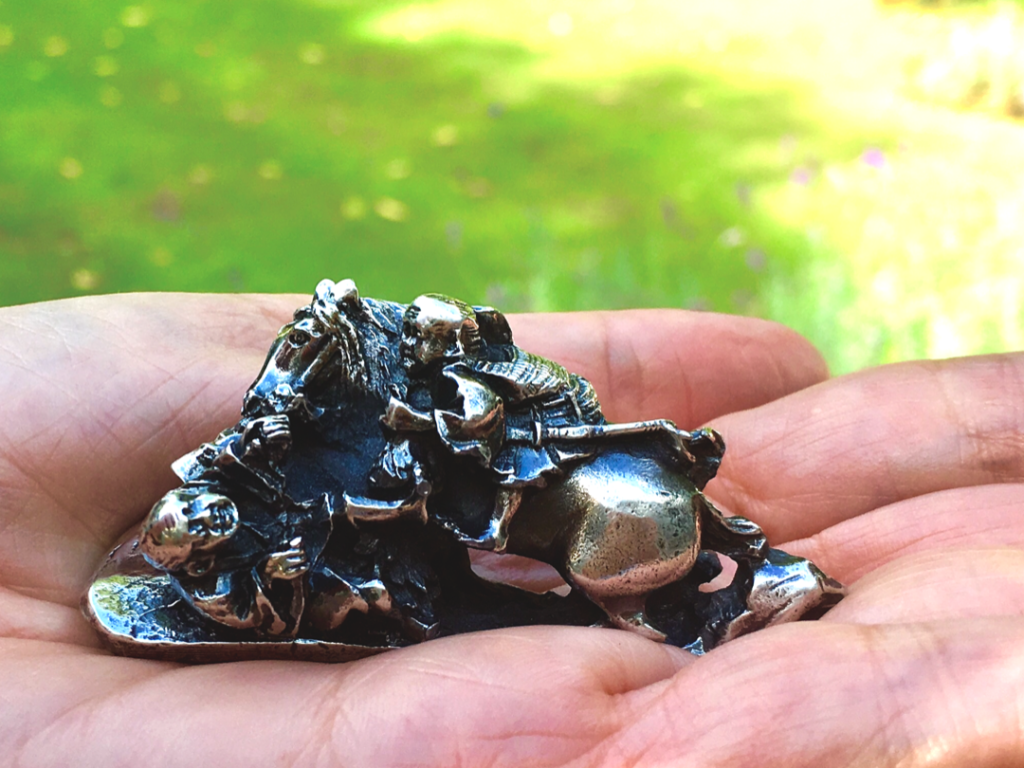Hi Everyone,
Last month I wrote about a Japanese measurement: handheld. Having not thought about this in ages, I revisited it again. Handheld—simple, small, intimate, caressing. It reminded me of my netsuke, a gift, an afterthought really, bought for me in an antiques shop in St Anton, Austria, from a proprietor who momentarily eyed me, weighing the odds. Was I the rightful owner?
My netsuke is small, made of metal, depicting a ferocious mounted samurai, long hair tied back, barefoot, sword at the ready, knocking over a careening old man—villain? victim?—all these figures easily encompassed in the palm of my hand. Polished and worn by the passage of time, both men’s heads along with the horse’s haunches shine.
A netsuke is a small, carved adornment worn as part of a Japanese man’s traditional dress, as a clasp for an item attached to the sash of a kimono. They are typically made of wood or ivory, but can include metal, bone, lacquer, clay and even bamboo. Netsuke originated as a practical solution and progressed to become examples of rare craftsmanship in miniature, depicting all aspects of Japanese society. Cupping mine in my hand to study it closely, I assume it to represent the triumph of good over evil, light over dark. I have often used it as a worry bead, adding to the lustre of the horse’s haunches and the samurai’s head.
I owned my netsuke long before I read one of my favourite books—The Hare with Amber Eyes by Edmund de Waal, a British ceramicist. It tells the story of the Ephrussis, a wealthy European Jewish banking line with similarities to the Rothschild family. In 1938, at the hands of the Nazis, the Ephrussis were forced to relinquish everything. After WWII the family failed to recover any of their fabulous wealth, except for a collection of 264 netuske, including the miniature hare with the amber eyes—all saved for them by one loyal employee. These netsuke provide a thematic thread throughout the book’s account of five generations of survival.
I read this memoir with rapt attention, not just because it brings to light the horror of the time, the tempest of the diaspora, but because it concerns itself with personal decision—the pivotal choice that must be made in times of political upheaval: to leave or to stay. When exactly does someone, some family, comfortably rooted in one place for generations, assess the prevailing political climate and make the heartbreaking decision to up stakes and begin again? Or else mistakenly decide to stick with the status quo, only to suffer a far worse outcome than exodus.
I read The Hare with Amber Eyes with the same bated breath as I read The Czar’s Madman by Jaan Kross, another book about the individual choice (or not) to leave in the face of tyranny. So captivated was I with Mr Kross’ story and his country of Estonia, I bought the film rights and adapted the book for the screen. Jaan Kross’ main character, aristocrat Timotheus von Bock (spoiler alert), after strenuous preparations to emigrate, at the bite of a succulent Estonian gooseberry, decides (unlike the Ephrussi family) that he cannot. Where else would he be Estonian, live out his history, speak his own language? Was he a madman or a realist? I still don’t know.
How does one make the decision in an uneasy political climate to go or to remain; to ensure the protection of family and fortune or, in the face of brutal tyranny, merely to survive? So my handheld netsuke holds a whole dynamic for me, as perhaps it once did when it served as the toggle on a Japanese gentleman’s kimono. Light over dark, good over evil, to go or to remain—how best to survive? My guess is, as with the Ephrussis’ netsuke, that eventually, like the arrival of a lone horseman, time will decide and ride on by, fait accompli.
Wishing you a happy and spirited September, with all the prevailing winds at your back.
Marlene

